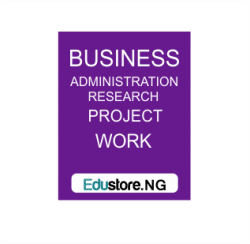multinational and indigenous food and beverage manufacturing companies in Nigeria.
The study investigated how these companies utilized marketing orientation and practices,
organizational structure and strategy , marketing strategies on acquisition of market
shares, usage of marketing mix elements on returns on capital employed, and how the
competitive use of these variables influence the perception of consumers. The research
study was developed around the theories of connectionist, personality, innovation
diffusion, and cost structure and business performance. These variables were used to
evolve a detailed analysis of issues relating to product quality, organizational structures
and management theories. Theoretical models were reflected and used in developing five
different hypotheses that were investigated through the survey of forty multinational and
one-hundred and twenty indigenous foods and beverage manufacturing companies which
were respectively randomly selected. Copies of well structured questionnaire were
administered to companies sampled. The validity and reliability of the instrument were
measured at Cronbach’s alpha of 0.69 and alternative form validity of 0.62. Five
hypotheses were raised and tested at 0.05 significant levels. The findings revealed that
marketing orientation adopted by multi-national companies (MNCs) yielded better
performance than those of indigenous companies (INCs), the structure/strategy adopted
by MNCs yielded better performance than those of INCs, marketing strategies adopted by
MNCs yielded more market shares than those of INCs, MNCs use of elements of
marketing mix yielded higher rates of returns on capital employed than that of INCs, and
competitive use of these 4Ps for consumers’ perception by MNCs yielded better
performance compared to that of indigenous counterparts. The conclusion from the
research findings showed that indigenous companies were unable to compete favourably
because of their limited financial resources. It was recommended that indigenous
companies should adopt competitive marketing, functional structure and strategy, with
five marketing divisions, competitive use of elements of marketing mix, and embark on
the production of food and beverages for export.
Title page …………………… (i)
Certification …………….(ii)
Declaration ………………(iii)….
Dedication………………………….(iv)
Acknowledgement ……………….. (v-ix)
Abstract ………………..(x)
Table of Contents……………………..(xi-xv)
List of Tables………….(xvi-xviii)
List of Figures……………………….(xix)
List of Charts…………………(xx)
List of Appendices……………….(xxi)
List of Models…………..(xxii)
List of Abbreviations………..(xxiii)
Chapter One: Introduction…. 1
1.1: Background of the Study……….1
1.2: Statement of the Research Problem. 3
1.3: Objectives of the Study….. 7
1.4: Research Questions……………….7
1.5: Research Hypotheses…………8
1.6: The Significance of the Study………9
1.7: Operationalization of Research Variables…..10
1.8: Scope of Study………………..11
1.9: Limitation of the Study………..12
1.10. Definition of Operational Terms……13
1.11: Organization of the Study……….14
1.12: References. 16
Chapter Two: Literature Review.. 19
2.1: Introduction……..19
2.2: Conceptual Framework………..19
2.2.1: Competitiveness in Marketing System……21
2.3: Types of Marketing Functions……………23
2.4: What is Competitive Marketing ?……..26
2.5: Company’s Organizational Structure/Strategy… 57
2.6: Multi-national Companies’ Operations……67
2.6.1: Employment Effects of MNEs by ILO……71
2.7: Importance of Marketing Strategies…….79
2.8: Competitive Analysis….. 90
2.9: Competitive Advantage………..91
2.10: Developing Marketing Strategies…………..92
2.11: Conventional and New Elements of Marketing Mix……..94.
2.12: Company’s Image for Good performance….. 107
2.13: Global Categorization of Food and Beverage Products.108
2.14: Theoretical Framework………..109
2.15. Corporate Differenciation……….109
2.16.2 Marketing Base Theory of Personality…………109
2.17: Some Theories on Organizational Structure and Strategies……110
2.18: Theories on Strategies………..112
2.19: Gap in Literature…… 118…
2.20 References…..121
Chapter Three: Research Methods….138
3.1: Introduction…….. 138
3.2: Research Methodology…..138
3.3: Research Design…….139
3.4: Population of the Study………..139
3.5: Sample Size Determination…………….140
3.6: Sampling Techniques………………142
3.7: Sample Frame…………..143
3.8: Research Instruments…..143
3.9: Administration of Research Instrument……145
3.10: Sources of Data……. 146
3.11: Method of Data Presentation and Analysis………..146
3.12: Validity of Research Instrument…….147
3.13: Reliability of Research Instrument.148
3.14: References…..150
Chapter Four: Presentation, Analysis, and Interpretation of
Results………. 151
4.1: Introduction…………..151
4.2: Analyses of Registered Members of F&B companies in Nigeria…. 152
4.3: Questionnaire Distribution/Response Rates, (MNCs/ICs). 153
4.4: Demographic and Socio-economic Characteristics of Respondents156……
4.5: Summary of Companies’ Classifications, Respondents’ Location, &
. Kinds of Operations………….158
4.6: Structural Presentation of Variables.160
4.7: Summaries Means & Standard Deviations of Variables.163
4.8: Test of Hypotheses (Summaries of Analysis of Variance) 171
4.9: Hypothesis One……. 171
. Hypothesis Two……. 174
. Hypothesis Three………….175.
. Hypothesis Four….177…..
. Hypothesis Five……………….179
4.10: References… 181
Chapter Five: Discussion, Conclusion, and Recommendations….. 182
5.1: Introduction……..182
5.2: Theoretical Findings….. 182
5.2.1: Marketing Orientation and Practices 182
. : Roles of Marketing………………182
. : Marketing Concept………………183
. : Marketing Environment……….183
. : Market Segmentation………..184
5.2.2: Organizational Structure……….184
5.2.3: Marketing Strategies Adoptable To Acquire More Market Shares… 185
5.2.3.1:Marketing Strategies Adoptable During Periods of Ample Supply of
Products186
5.2.3.2: Marketing Strategies Adoptable During Periods of Short Supply
.. of Products Situation………..186……
5.2.4: Use of Product, Price, Place, and Promotion to Earn Returns on Capital
..Employed………………..187.
5.2.4.1: Growth of Company’s Profit Using Product, Price, Place and Promotion. 188
5.3:.Empirical Findings…………189
5.3.1: Hypothesis One………….189
5.3.2: Hypothesis Two………….191
5.3.3: Hypothesis Three…… 191
5.3.4: Hypothesis Four……………….193
5.3.5: Hypothesis Five………….195
5.4: Performance Indexes of Multi-national vis-Ã -vis Indigenous
. Companies in Food and Beverage Industry in Nigeria (2001-2005)… 195
5.5: Conclusion……………196
5.6: Implications of the Findings…………….198
5.7: Contributions to Knowledge….200
5.8: Suggestions for Further Research……..201
BIBLIOGRAPHY…. 209-229.
= JOURNALS…209-217
= BOOKS….218-226
= INTERNET SOURCES….. 227-228
= OTHER PUBLICATIONS….. 229
Appendices….. 230-242
.Appendix 1: QUESTIONNAIRE……230-240
LIST OF TABLES Page(s)
Table 2.1:.Market Driven Business viz-a-viz Internally Oriented Business………30
Table 2.2:.Sun Tzu’s Six Varieties of Terrain…..87
Table 2.3:.Sun Tzu’s Nine Varieties of Ground…. 90
Tables2.4&5: Analysis of 7Ps of Marketing Mix…. 101
Table 4.1:.Registered Members of Food, Beverage, and Tobacco…. 152
Table 4.2: Harmonized Geographical Spread of Registered Food and Beverage Companies in Nigeria.. 153
Table 4.3:.Questionnaire Distribution/Response Rates (Multi-national Companies). 154.
Table 4.4 : Analysis of Registered Indigenous Companies and their Percentage Contributions…….155
Table 4.5: Questionnaire Distribution/Response Rates of (Indigenous Companies)……..155
Table 4.6:.Demographic & Socio-economics Characteristics of Respondents. 157……
Table 4.7; Perception of Respondents on Kinds of Company & Position in the Industry……………..158
Table 4.8: Summary of Means and Standard Deviations of Marketing Roles of both Multi-national and Indigenous Companies163
Table 4.9: Summary Means and Standard Deviations of Marketing Concepts of both Multi-national and Indigenous Companies.164
Table 4.10: Summary of Means and Standard Deviations of Marketing Environment of both Multi-national and Indigenous Companies. 165
Table 4.11: Summary of Means and Standard Deviations of Market Segmentation of both Multi-national and Indigenous Companies..166.
Table 4.12: Summary of Means and Standard Deviations of Organizational Structures of both Multi-national and Indigenous Companies… 167
Table 4.13: Summary of Means and Standard Deviations Using Marketing mix Elements of both Multi-national and Indigenous Companies..168
Table 4.14: Summary of Means and Standard Deviations of Marketing Strategies of both Multi-national and Indigenous Companies During Period of Ample Supply of Products….. 170
Table 4.15: Summary of Means and Standard Deviations of Marketing Strategies of Both Multi-national and Indigenous Companies During Period of Short Supply of Products 171
Table 4.16: Mean and Standard Deviation of Marketing Orientation Adopted by Multinational and Indigenous Companies’ in Relation to their Respective Attained Performances….. 172
Table 4.17: Summary of Analysis of Variance on Marketing Orientation and Practices Adopted and Performances Attained by Multi-national and Indigenous Companies respectively……….172
Table 4.18: Means and Standard Deviations on Company’s Structures Adopted and Performances Attained by Multi-national and Indigenous Companies…………..174
Table 4.19: Summary of Analysis of Variance on Company’s Structure Adopted and Performance Attained by Multi-national and Indigenous Companies ……..175
Table 4.20: Means and Standard Deviations of Marketing Strategies Adopted and the Extent of the Market Shares Attained by Multinational and Indigenous Companies’ Respectively….. 176
Table 4.21: Summary of Analysis of Variance on Marketing Strategies Adopted and Attained Market Shares by Multinational and Indigenous Companies Respectively………..176
Table 4.22: Means and Standard Deviations on the Use of Marketing Mix Elements, and the Returns on Capital Employed by Multinational and Indigenous Companies Respectively… 177
Table 4.23: Summary of Analysis of Variance on the Adoption of Marketing mix in form of Product, Price, Place, and Promotion and Returns on Capital Employed by Multinational and Indigenous Companies Respectively………178
Table 4.24: Means and Standard Deviations of Corporate Image and Performances of Multi-national and Indigenous Companies Respectively…..179
Table 4.25: Summary of Analysis of Variance of Perceived Corporate Image and the Attained Performances by Multi-national and Indigenous Companies Respectively…. 180
Table 5.1: Performance Indices of Multi-national and Indigenous Companies in Food and Beverage Industry in Nigeria: Comparative Analysis (2001 ” 2005)………..196
LIST OF FIGURES
Figure 2.1: Model of Literature Review on Competitive Marketing….. 20
Figure 2.2: Modified 3-Stages of Evolution of Marketing in U.S.A….. 33
Figure 2.3: The Marketing Concept ………….34
Figure 2.4: Model of Marketing Concept. …………….36.
Figure 2.5: Model of Marketing Environment ……..44
Figure 2.6: Specimen of Organizational Structure Relating to Multinational Organizations Involved in International and Export Business….. 60
Figure 2.7: Mother-Daughter Subsidiary Linkage Model….62
Figure 2.8: Specimen Company’s Organogram……..63
Figure 2.9: Forms or Classification of Organizational Structure..64
Figure 2.10: Model of Small Businesses Characteristics..71
Figure 2.11:Model of Porter’s Three Generic Strategies..80
Figure 2.12: Model of Defensive Strategies……….83
Figure 2.13 The Five-Forces Model of Competition…….90
Figure 2.14 McCarthy, Jerome’ 4Ps of Marketing Mix95
Figure 2.15: Market Share Development Tree……..104
Figure 2.16: Sub-Categories of Food and Beverage Products…108
Figure 2.17:A Stage-by-Stage Diagrammatical Presentation of MNC Evolution.. 111
Figure 2.18: Simplified Version of the Philips, Chang and Buzzel Model….. 113
Figure 2.19: Roger’s Adoption/ Innovation Curve………….117
LIST OF CHARTS
Chart 1: Nature of Companies (Pie Chaet)……….159
Chart 11:Types of Companies (Pie Chart) ……….160
LIST OF APPENDICES
Appendices………..230-242.
Appendix 1: QUESTIONNAIRE….. 230-242
LIST OF MODELS GENERATED BY THE RESEARCHER
2.1 : Model of Literature Review on Competitive Marketing……………..20
2.10: Model of Small Business Characteristics….. 71
2.16: Step-by-Step Diagrammatical Presentation of MNCs Evolution (Phataric Theory)……..111
Models of Structural Presentations of Variables….. 160
4.3.1 Marketing Orientation and Practices Model……160
4.3.2 Organizational Structural Model…161
4.3,3 Strategies Marketing Model…. 161
Summary Explanation on Model Specification….162
LIST OF ABBREVIATIONS
IMC = Integrated Marketing Communication.
F&B = Food and Beverage Companies.
FAO = Food and Agriculture Organizations.
MNCs = Multi-national Companies.
INCs = Indigenous Companies.
R & D = Research and Development.
QSRB = Quick Service Restaurant Business
AMA = American Marketing Association
DM= Direct Marketing.
SWOT. = Strength, Weakness, Opportunity, and Threats.
OPMIC. = Organizational Performance of Multi-national and Indigenous Companies.
CMPMIC = Competitive Marketing of Multinational and Indigenous Companies.
ROCE = Returns on Capital Employed.
AFBTE = Association of Food, Beverage and Tobacco Employers’
MNE = Multi-national Enterprises
MAN.. = Manufacturers’ Association of Nigeria.
SITC.. = Standard International Trade Classification..
- For Reference Only: Materials are for research, citation, and idea generation purposes and not for submission as your original final year project work.
- Avoid Plagiarism: Do not copy or submit this content as your own project. Doing so may result in academic consequences.
- Use as a Framework: This complete project research material should guide the development of your own final year project work.
- Academic Access: This platform is designed to reduce the stress of visiting school libraries by providing easy access to research materials.
- Institutional Support: Tertiary institutions encourage the review of previous academic works such as journals and theses.
- Open Education: The site is maintained through paid subscriptions to continue offering open access educational resources.






